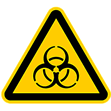Safety in the Laboratory

Safety in the Laboratory |
 |
Working on samples under sterile conditions (protecting the experiment). Protecting the experimentator against biological agents. Risk of contamination by biological material Minor risk of UV-exposure → UV-light should turn off automatically, when front window is open Minor risk of gas or solvent explosion → gas burners should not be used inside of a safety cabinet → solvents (e.g. EtOH) should not be used extensively see "SI Safety cabinet" |

|
Use disposable gloves: → protects experiment against contamination from the experimentators hands → protects experimentators hands when much EtOH have to be used for frequent hand disinfection during experimentation |

|
 Not safe working area |
 Safety cabinet class 1 |
 Safety cabinet class 1 aka cleanbench |
| Not steril air (red arrow) enters the system. This air is sterilized by an HEPA-filter. Sterile air (blue arrow) is blown over the experiment toward the experimentator. With this air flow aerosols can be transported from the experiment to the experimenator This protects only the experiment, not the experimentator! |
Not steril air (red arrow) enters to the working area. this ensures that areosols from the experiment will not leave the system. Possibly contaminated exhaust air is steril filtrated by HEPA-filter. This protects only the experimentator, not the experiment! |
Not steril air enters the system (red arrow) but is directed below the working area. → aerosols can not leave (protects experimentator). → vent slot should not be tapped (protects experiment) behind working area not steril air is blown upwards. 2/3 of this air is steril filtrated (HEPA) and blown laminarly to the experiment (blue arrow). → never disturb this laminar airflow! 1/3 is as exhaust air steril filtrated, too. This protects the experimentator, AND the experiment! |
